
IN SILENCE AND MOVEMENT YOU CAN SHOW THE REFLECTION OF PEOPLE
first performed on
March 12, 2011
the lawns of the Museum of Contemporary Art, Sydney, Australia
performed twice in 2011
SYLVIA SCHWENK
Sydney, Australia / Berlin, Germany
101852365s101852365t101852365s101852365c101852365h101852365w101852365e101852365n101852365k101852365@101852365y101852365a101852365h101852365o101852365o101852365.101852365c101852365o101852365m101852365.101852365a101852365u
schwenk.com.au
IN SILENCE AND MOVEMENT YOU CAN SHOW THE REFLECTION OF PEOPLE
SYLVIA SCHWENK
A work of participatory performance art, which was performed by everyday people in a real life context in front of a construction site at the Museum of Contemporary Art. The work draws attention to ordinary events or actions that normally go unnoticed, in particular tradesmen installing and removing sheets of glass. The performance reminds us in a small way that history is the total sum of ordinary things: life is not the result of significant events, but the culmination of small, everyday acts, things, coincidences and encounters.
The project, which takes its name from a quote by the French actor and mime Marcel Marceau, saw performers become tradesmen-dressed in yellow overalls, yellow hardhats, white gloves and black boots, equipped with glass suckers-moving sheets of pretend “glass” from the front of the MCA to the edge of Sydney Harbour’s Circular Quay and back. In the week(s) leading up to the performance, I met everyday people who shared the public space where the work was to be presented and invited them to become performers. On the day of the performance, I directed a 30 minute rehearsal immediately before the “live” performance, where the performers-people who did not know each other-started working together, communicating with one another, helping each other, and implicitly trusting each other to present the work in a professional and cohesive way-transforming themselves from a group of individuals into a unified group of performers. The work typifies “performosis’-a term I created to encapsulate the way in which everyday people become performers in participatory performance art, and spectators and passersby performing their everyday activities become active parts of the performance in public space.
The performance also highlights the effect context has on art and its audience. As the work approached the entrance to the MCA, the performance inherently started to carry an art frame signalling that the audience should turn their art filter on and alter their behaviour. The audience started to respond to the work with awe and deference, becoming quiet, and moving to the edge of the area, opening up a distinct space between the performance and themselves. They metaphorically elevated and placed the performance on an art platform or pedestal. As the work moved closer to Circular Quay, it presented itself as an intervention in a public space and the work became more accessible. The audience were curious, and actively engaged with the work in a more relaxed way, giving themselves permission to be attracted and inquisitive. They allow themselves to engage “performotically.” During the performance, for example, some spectators started polishing the “glass,” some ran through sheets of “glass” smashing them into shards, while others started carrying their own sheets of “glass.”